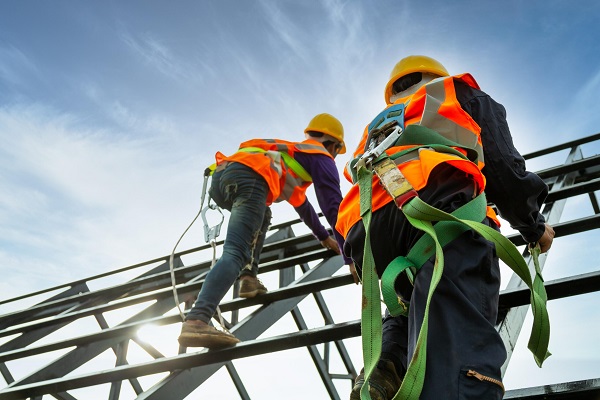Construction sites are dynamic and often hazardous environments where safety should always be the top priority.
According to the Occupational Safety and Health Administration (OSHA), construction workers are among the most at risk for workplace injuries, with common hazards including falls, equipment-related accidents, and exposure to harmful substances.
To protect your team and ensure a safe working environment, implementing essential safety measures is critical. Here’s a comprehensive guide to some key safety tips for construction workers.
1. Personal Protective Equipment (PPE)
A. Hard Hats
Wearing hard hats is essential to protect workers from head injuries caused by falling objects or accidental bumps. Ensure that hard hats are certified and fit properly.
B. Safety Glasses
Protective eyewear shields workers from dust, debris, and harmful radiation. Select safety glasses that meet the ANSI Z87.1 standards.
C. Gloves
Appropriate gloves should be chosen based on the tasks at hand. For instance, cut-resistant gloves are ideal for handling sharp objects, while insulated gloves can protect against electrical hazards.
D. High-Visibility Clothing
Bright, reflective clothing makes workers more visible to operators of heavy machinery, reducing the risk of accidents.
E. Footwear
Steel-toed boots are essential to protect feet from heavy objects and falling tools. Slip-resistant soles can also prevent falls on slippery surfaces.
2. Training and Education
A. Safety Training Programs
Implement comprehensive safety training programs for all workers. Regular training should cover:
- Hazard Recognition: Teach workers how to identify potential hazards on site.
- Safe Operating Procedures: Educate workers on the safe use of tools and equipment.
- Emergency Response: Train staff on how to respond to emergencies, including evacuation procedures and first aid.
B. Toolbox Talks
Conduct regular toolbox talks to discuss specific safety topics relevant to ongoing tasks. This encourages open communication about safety concerns and reinforces best practices.
3. Hazard Communication
A. Safety Data Sheets (SDS)
Ensure that SDS are readily accessible for all hazardous materials used on site. Workers should understand how to read and interpret these sheets.
B. Labeling
Properly label all chemicals and hazardous materials. Clear labeling helps workers quickly identify dangers and respond appropriately.
4. Worksite Organization and Maintenance
A. Clean and Organized Work Area
Keep the worksite tidy to minimize trip hazards. Regularly remove debris, tools, and materials from walkways and work areas.
B. Proper Storage of Tools and Materials
Store tools and materials safely to prevent falls and injuries. Use designated storage areas and ensure that items are stacked securely.
C. Signage
Use clear signage to indicate hazards, restricted areas, and safety protocols. Signs should be easily visible and understandable.
5. Fall Protection
A. Use of Guardrails and Safety Nets
Install guardrails, safety nets, and personal fall arrest systems on elevated work areas to protect workers from falls.
B. Ladders and Scaffolding
Ensure that ladders are stable, and scaffolding is erected correctly. Regularly inspect equipment for damage and wear.
C. Training on Fall Hazards
Provide specific training on the risks associated with working at heights and the proper use of fall protection equipment.
6. Equipment Safety
A. Regular Inspections
Conduct routine inspections of all machinery and equipment to ensure they are in safe working condition. This includes checking for wear and tear, leaks, and proper functionality.
B. Operator Training
Only trained and authorized personnel should operate machinery. Provide adequate training for all equipment to minimize the risk of accidents.
C. Lockout/Tagout Procedures
Implement lockout/tagout procedures to ensure that machinery is properly shut down and cannot be started up again until maintenance or repairs are complete.
7. Health and Wellness
A. Monitor Weather Conditions
Ensure workers are aware of weather conditions that may impact safety, such as extreme heat, cold, or storms. Implement measures to protect workers from the elements.
B. Promote Ergonomics
Encourage ergonomic practices to reduce strain and injury from repetitive tasks. Train workers on proper lifting techniques and provide assistance when handling heavy objects.
C. Mental Health Support
Recognize the importance of mental health in the workplace. Provide resources for workers to address stress, anxiety, or other mental health issues.
8. Emergency Preparedness
A. Emergency Action Plans
Develop and communicate a clear emergency action plan. Ensure that all workers know the evacuation routes, emergency contacts, and the location of first aid kits.
B. First Aid Training
Train designated employees in first aid and CPR to provide immediate assistance in case of an injury or emergency. Keep first aid kits stocked and accessible.
C. Regular Drills
Conduct regular emergency drills to ensure all workers are familiar with the procedures and can respond quickly in an actual emergency.
Conclusion
Safety on construction sites is paramount for protecting workers and ensuring a productive work environment. By implementing these essential safety tips, construction managers can foster a culture of safety and responsibility among their teams.
Regular training, effective communication, and a commitment to adhering to safety protocols will significantly reduce the risk of accidents and injuries. Remember, a safe worksite is a productive worksite, and investing in safety measures ultimately benefits everyone involved.
Also Read
How to choose the right contractors: Expert tips and advice
Understanding construction contracts: Tips for better negotiation

